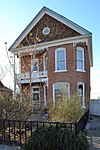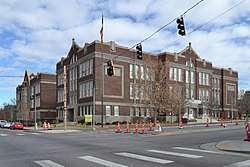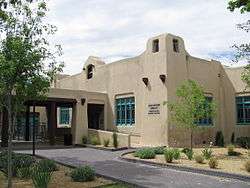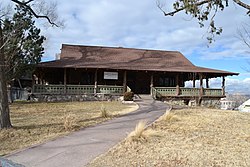Huning Highlands Historic District
The Huning Highlands Historic District is a historic district in Albuquerque, New Mexico which encompasses the entirety of the Huning Highlands neighborhood. The district is bounded by Dr. Martin Luther King Jr. Avenue to the north, Locust Street to the east, Iron Avenue to the south, and the Burlington Northern Santa Fe railroad tracks to the west, covering an area of about 0.3 square miles (0.78 km2). The neighborhood was Albuquerque's first residential subdivision and was mostly developed between the 1880s and 1920s. It is known for its high concentration of Victorian and early 20th-century houses.[3] The district was added to the New Mexico State Register of Cultural Properties in 1976 and the National Register of Historic Places in 1978.[2]
Huning Highlands Historic District | |
.jpg) The Seth House | |
  | |
| Location | Huning Highlands, Albuquerque, New Mexico |
|---|---|
| Coordinates | 35°04′59″N 106°38′28″W |
| NRHP reference No. | 78001804[1] |
| NMSRCP No. | 464 |
| Significant dates | |
| Added to NRHP | November 17, 1978 |
| Designated NMSRCP | August 27, 1976[2] |
History
The Atchison, Topeka, and Santa Fe Railway reached Albuquerque in 1880, fueling land speculation as investors hoped to profit from its arrival. The New Mexico Town Company, formed by local businessmen Franz Huning, Elias S. Stover, and William Hazeldine, succeeded in attracting the railroad facilities to their chosen site about 1.5 miles (2.4 km) from the existing community at Old Town. The 3.1-square-mile (8.0 km2) parcel they assembled quickly developed into the booming community of New Town—today's Downtown.[4] Huning also owned land in the rolling sandhills further to the east, which was known as the Highlands due to its elevation. In 1880, the land was platted as the first subdivision to be added to the original townsite. This new neighborhood was named Huning's Highland Addition, which later shifted to Huning Highlands.[5]
The neighborhood was laid out by civil engineer Walter G. Marmon, who named the main north-south streets Arno, after Franz Huning's son, Walter and Edith after his own son and daughter, and Broadway, because "every town should have a Broadway".[5] The uppermost street of the gently sloping neighborhood was named High Street. The Highlands quickly became one of Albuquerque's most popular residential areas and was home to many of the city's prominent early residents. Unlike the old Hispanic neighborhoods like Old Town, Barelas, and Atrisco, Huning Highlands was primarily built by recently arrived Anglo-Americans and European immigrants. As such, the houses in the neighborhood reflected styles and materials popular in the eastern and Midwestern United States—Queen Anne, Italianate, and other Victorian styles—rather than traditional regional forms. Most of the houses were built using prefabricated trim and architectural elements in a mix-and-match approach not adhering to any particular style, though some are more cohesive.[5]
The neighborhood continued to fill in between the 1880s and 1920s, by which time it was almost completely built up.[5] Residents enjoyed amenities like Highland Park, one of the city's oldest public parks, the Old Main Library, and an electric streetcar line which went into service in 1911.[6] However, as the city continued to grow, many wealthy residents abandoned the older inner-city neighborhoods in favor of the more suburban developments further to the east. By the 1970s, Huning Highlands had become a relatively poor neighborhood consisting largely of absentee-owned rental housing.[3]
The Huning Highlands Historic District was added to the National Register of Historic Places in 1978 and in 1980, the Albuquerque City Council approved the city's first Historic Overlay Zone for the neighborhood.[7] The city designation requires approval from the Landmarks and Urban Conservation Commission for any alterations to contributing properties in the district and provides tax incentives for home restoration projects.[8] These actions had a positive effect on the neighborhood and led to many of the historic houses being restored. According to the Huning Highlands Historic District Association, the percentage of properties that were considered "blighted or substandard" decreased from 52% in 1976 to 17% in 1986 and was estimated at less than 5% by 2005.[9]
Notable buildings
| Name | Image | Location | Year built | Style | Notes |
|---|---|---|---|---|---|
| AT&SF Memorial Hospital |  |
806 Central Ave. SE 35°4′57″N 106°38′17″W |
1926 | Mediterranean Revival | Albuquerque landmark |
| E. J. Alger House |  |
124 Walter St. SE | 1900[10] | Italianate | |
| Auge Store |  |
214 Arno St. NE | c. 1908[11][12] | ||
| D. A. Bittner House |  |
120 Walter St. SE | 1901 | Dutch Colonial Revival | |
| Boatright House |  |
220 Edith Blvd. SE | 1888 | Queen Anne | David Boatright was an early mayor of Albuquerque. |
| Charles E. Boldt House |  |
323 Edith Blvd. SE | c. 1904 | Dutch Colonial Revival | |
| D. R. Boyd House |  |
123 High St. SE | c. 1895 | Queen Anne | |
| G. E. Brewer House |  |
215 Walter St. SE | 1901 | Queen Anne | |
| T. I. Butts House |  |
201 High St. NE | c. 1909 | Queen Anne | |
| Children's Home and Hospital (Regina Hall) |  |
806 Dr. Martin Luther King Jr. Ave. NE |
c. 1921 | Prairie School | |
| H. G. Coors House |  |
116 Walter St. SE | c. 1920 | Bungalow | |
| P. G. Cornish House |  |
123 Walter St. SE | c. 1900[13] | Queen Anne | |
| Edward Buxton Cristy House |  |
201 Walter St. SE | 1897 | Queen Anne | E. B. Cristy was an architect and designed the house himself. |
| Duplex at 108-110 Arno SE |  |
108-110 Arno St. SE | c. 1898 | Folk Victorian | |
| J. L. Durling House |  |
410 Edith Blvd. SE | c. 1894 | Stick | |
| Andrew Hatch House |  |
218 Walter St. SE | 1901 | Folk Victorian | |
| Highland Hotel |  |
202 Central Ave. SE 35°5′1″N 106°38′44″W |
1906[14] | Chicago School | Albuquerque landmark |
| Mrs. Hill's Boarding House |  |
321 Walter St. SE | c. 1890 | Queen Anne | |
| Horner House |  |
520 Arno St. SE | 1881 | Oldest known house in district | |
| House at 204 Arno SE |  |
204 Arno St. NE | c. 1882 | ||
| House at 210 High SE |  |
210 High St. SE | c. 1895 | Folk Victorian | |
| House at 212 High SE |  |
212 High St. SE | c. 1890 | Queen Anne | |
| House at 306 Walter SE |  |
306 Walter St. SE | 1907 | Queen Anne | |
| House at 317 Walter SE |  |
317 Walter St. SE | c. 1890 | Folk Victorian | |
| House at 320 Edith SE |  |
320 Edith Blvd. SE | c. 1903 | Folk Victorian | |
| House at 411 Arno St. SE |  |
320 Edith Blvd. SE | c. 1890s | Queen Anne | |
| Jack Korber House |  |
301 Arno St. SE | 1916 | Prairie School | |
| J. E. Learnard House |  |
210 Walter St. SE | 1898[15] | Queen Anne | |
| W. J. Marsh House |  |
301 Edith Blvd. SE | c. 1895 | Folk Victorian | |
| C. L. McClanahan House |  |
201 Arno St. SE | 1910 | Queen Anne | |
| A. B. McMillan House |  |
119 Walter St. SE | 1896 | Queen Anne | |
| McQuade House |  |
201 Walter St. NE | 1901 | Queen Anne | |
| I. J. Mize House |  |
316 Walter St. SE | c. 1900 | Folk Victorian | |
| Old Albuquerque High School |  |
Central and Broadway NE 35°5′3″N 106°38′38″W |
1914 | Collegiate Gothic | SR 1977 Albuquerque landmark |
| Old Main Library |  |
423 Central Ave. NE 35°5′2″N 106°38′33″W |
1925 | Pueblo Revival | SR 1975 Albuquerque landmark |
| F. J. Patchin House |  |
207 High St. NE | 1906[16] | Dutch Colonial Revival | |
| Seth House | .jpg) |
322 Arno St. SE | c. 1883 | Folk Victorian | |
| C. E. Vaughn House |  |
423 Arno St. SE | c. 1900 | Queen Anne | |
| William Whitney House |  |
302 Walter St. SE | 1907 | Neoclassical | |
| Whittlesey House |  |
201 Highland Park Cir. SE 35°4′54″N 106°38′21″W |
1903 | Norwegian Vernacular | SR 1975 Albuquerque landmark |
References
- "National Register Information System". National Register of Historic Places. National Park Service. March 13, 2009.
- "State and National Register Spreadsheet" (Excel). New Mexico Department of Historic Preservation. Retrieved May 29, 2020.
- "National Register of Historic Places Inventory/Nomination: Huning Highlands Historic District". National Park Service. November 17, 1978. with 57 accompanying photos
- Kammer, David. "Albuquerque's 20th-Century Suburban Growth". New Mexico Office of the State Historian. Retrieved September 28, 2017.
- Dewitt, Susan (1978). Historic Albuquerque Today: An Overview Survey of Historic Buildings and Districts. Albuquerque: Historic Landmarks Survey of Albuquerque. pp. 88–96.
- "First electric car travels to the Highlands". Albuquerque Journal. February 16, 1911. Retrieved March 21, 2018 – via Newspapers.com.
- Burks, Susanne (May 14, 1980). "City to Change Plan for New Road on West Mesa". Albuquerque Journal. Retrieved June 30, 2020 – via Newspapers.com.
- Sandoval, Arturo (June 23, 1980). "Past Getting New Lease on Life in Huning Area". Albuquerque Journal. Retrieved June 30, 2020 – via Newspapers.com.
- Sanchez, Isabel (March 11, 2005). "Dim 'View' of City Blasted". Albuquerque Journal. Retrieved June 30, 2020 – via Newspapers.com.
- "Local Paragraphs". Albuquerque Citizen. January 30, 1900. Retrieved July 3, 2020 – via Newspapers.com.
- "About Town". Albuquerque Citizen. October 12, 1907. Retrieved July 3, 2020 – via Newspapers.com.
- Worley's Directory of Albuquerque, New Mexico 1908-1909. Dallas: John F. Worley Directory Co. 1908. p. 75. Retrieved July 3, 2020.
- "Local and Personal". Albuquerque Journal. November 29, 1900. Retrieved July 3, 2020 – via Newspapers.com.
- "Local Items of Interest". Albuquerque Journal. March 15, 1906. Retrieved July 3, 2020 – via Newspapers.com.
- "Personal Mention". Albuquerque Journal. January 22, 1898. Retrieved July 3, 2020 – via Newspapers.com.
- "Local and Personal". Albuquerque Citizen. November 2, 1906. Retrieved July 3, 2020 – via Newspapers.com.